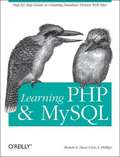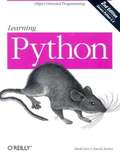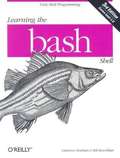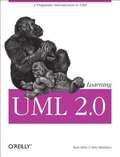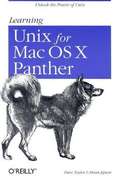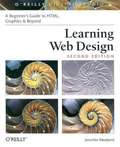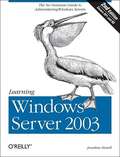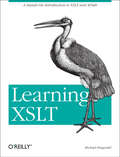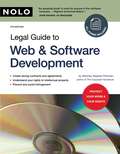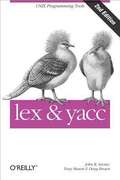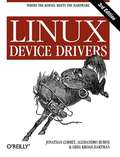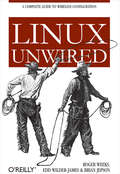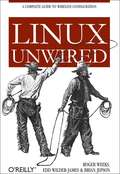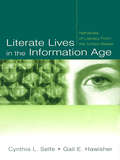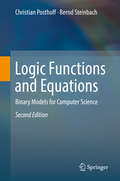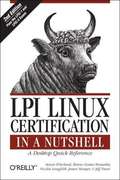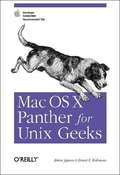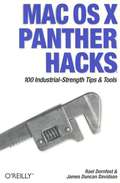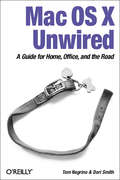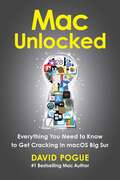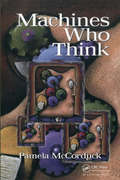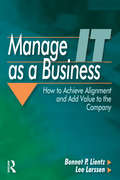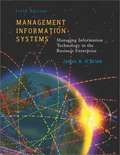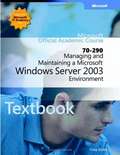- Table View
- List View
Learning PHP and MySQL
by Michele Weiner Davis Jon PhillipsThe PHP scripting language and MySQL open-source database are quite effective independently, but together they make a simply unbeatable team. When working hand-in-hand, they serve as the standard for the rapid development of dynamic, database-driven websites. This combination is so popular, in fact, that it's attracting many programming newbies who come from a web or graphic design background and whose first language is HTML. If you fall into this ever-expanding category, then this book is for you. Learning PHP and MySQL starts with the very basics of the PHP language, including strings and arrays, pattern matching and a detailed discussion of the variances in different PHP versions. Next, it explains how to work with MySQL, covering information on SQL data access for language and data fundamentals like tables and statements. Finally, after it's sure that you've mastered these separate concepts, the book shows you how to put them together to generate dynamic content. In the process, you'll also learn about error handling, security, HTTP authentication and more. If you're a hobbyist who is intimidated by thick, complex computer books, then this guide definitely belongs on your shelf. Learning PHP and MySQL explains everything--from basic concepts to the nuts and bolts of performing specific tasks--in plain English. Part of O'Reilly's bestselling "Learning" series, the book is an easy-to-use resource designed specifically for newcomers. It's also a launching pad for future learning, providing you with a solid foundation for more advanced development.
Learning Python, 2nd Edition
by David Ascher Mark LutzLearning Python , Second Edition offers programmers a comprehensive learning tool for Python and object-oriented programming. Thoroughly updated, this guide introduces the basic elements of the latest release of Python 2.3 and covers new features, such as list comprehensions, nested scopes, and iterators/generators.
Learning the bash Shell, 3rd Edition
by Cameron NewhamThis refreshed edition serves as the most valuable guide yet to the bash shell. It's full of practical examples of shell commands and programs guaranteed to make everyday use of Linux that much easier. Includes information on key bindings, command line editing and processing, integrated programming features, signal handling, and much more!
Learning UML 2.0
by Russell Miles Kim Hamilton"Since its original introduction in 1997, the Unified Modeling Language has revolutionized software development. Every integrated software development environment in the world--open-source, standards-based, and proprietary--now supports UML and, more importantly, the model-driven approach to software development. This makes learning the newest UML standard, UML 2.0, critical for all software developers--and there isn't a better choice than this clear, step-by-step guide to learning the language." --Richard Mark Soley, Chairman and CEO, OMG If you're like most software developers, you're building systems that are increasingly complex. Whether you're creating a desktop application or an enterprise system, complexity is the big hairy monster you must manage. The Unified Modeling Language (UML) helps you manage this complexity. Whether you're looking to use UML as a blueprint language, a sketch tool, or as a programming language, this book will give you the need-to-know information on how to apply UML to your project. While there are plenty of books available that describe UML, Learning UML 2.0 will show you how to use it. Topics covered include: Capturing your system's requirements in your model to help you ensure that your designs meet your users' needs Modeling the parts of your system and their relationships Modeling how the parts of your system work together to meet your system's requirements Modeling how your system moves into the real world, capturing how your system will be deployed Engaging and accessible, this book shows you how to use UML to craft and communicate your project's design. Russ Miles and Kim Hamilton have written a pragmatic introduction to UML based on hard-earned practice, not theory. Regardless of the software process or methodology you use, this book is the one source you need to get up and running with UML 2.0. Additional information including exercises can be found at www.learninguml2.com . Russ Miles is a software engineer for General Dynamics UK, where he works with Java and Distributed Systems, although his passion at the moment is Aspect Orientation and, in particular, AspectJ. Kim Hamilton is a senior software engineer at Northrop Grumman, where she's designed and implemented a variety of systems including web applications and distributed systems, with frequent detours into algorithms development.
Learning Unix for Mac OS X Panther
by Brian Jepson Dave TaylorThis compact book provides a user-friendly tour for the uninitiated of the Mac Unix base. You can safely explore Terminal and familiarize yourself with the command line, learning as you go about the hundreds of Unix programs that come with your Mac. You'll begin to understand the power and flexibility of Unix. And if Unix isn't new to you, you'll discover how it translates into this latest Mac incarnation. Updated to cover Mac OS X Panther (Mac OS X 10.3), this book will keep you current with the latest features of your Mac.
Learning Web Design, 2nd Edition
by Jennifer Niederst RobbinsIn Learning Web Design , author Jennifer Niederst shares the knowledge she's gained from years of web design experience, both as a designer and a teacher. This book starts from the beginning-- defining the Internet, the Web, browsers, and URLs -- so you don't need to have any previous knowledge about how the Web works. After reading this book, you'll have a solid foundation in HTML, graphics, and design principles that you can immediately put to use in creating effective web pages. In the second edition, Jennifer has updated the book to cover style sheets and reflect current web standards. She has also added exercises that help you to learn various techniques and short quizzes that make sure you're up to speed with key concepts. The companion CD-ROM contains material for all the exercises in the book, as well as trial versions of Fireworks MX, and HomeSite 5; Adobe Photoshop 7, ImageReady 7, and BBEdit 7.* Learning Web Design , 2nd Edition: Covers the nuts and bolts of basic HTML and style sheets, with detailed examples of formatting text, adding graphic elements, making links, creating tables and frames, and using color on the Web. Explains whether to use GIFs or JPEGs for different types of images, and includes important tips on optimizing graphics for web delivery. Provides dozens of web design do and don'ts, to help you make good web design decisions and avoid common beginner traps. Contains hands-on exercises throughout the book that allow you to try out new techniques along the way. Unlike other beginner books, Learning Web Design leaves no holes in your education. It gives you everything you need to create basic web sites and will prepare you for more advanced web work. If you are interested in web design, this book is the place to start. After finishing it, you'll be ready for the author's bestselling companion reference, Web Design in a Nutshell . * Fireworks and HomeSite are trademarks or registered trademarks of Macromedia, Inc. in the United States and/or other countries. Adobe, ImageReady, and Photoshop are either registered trademarks or trademarks of Adobe Systems Incorporated in the United States and/or other countries.
Learning Windows Server 2003, 2nd Edition
by Jonathan HassellGetting Microsoft Windows Server 2003 up and running, either as a standalone or as part of a multi-site, multi-server network is a formidable task for anyone. O'Reilly's no-nonsense guide, Learning Windows Server 2003, 2nd Edition , gives you just what you need to get the job done. It provides you with the nuts and bolts for installing, configuring, securing, and managing Windows Server 2003-plus, it has been completely updated for Service Pack 1 and release R2. Learning Windows Server 2003, 2nd Edition includes just enough theory for you to understand how the different features and systems work in this latest version of Windows. You'll come away with a firm understanding of what's happening under the hood of the system, but without feeling like you're taking a graduate course in OS theory. After its high-level overview, the book offers complete discussions and treatments of all of Server 2003's major components. You'll learn how to: install Windows Server 2003 create and manage user accounts (with particular attention to Active Directory) manage access to system resources, such as printers and files configure and manage its numerous major subsystems The book also features step-by-step procedures and discussions of complex concepts such as patch management, Active Directory replication, DFS namespaces and replication, network access quarantining, server clustering, Group Policy and other security tools, and IIS6 web server. Whether you're an experienced system administrator or one who's just beginning, you'll turn to this practical guide again and again when you need to understand the massive product that is Windows Server 2003.
Learning XSLT: A Hands-On Introduction to XSLT and XPath
by Michael FitzgeraldLearning XSLT moves smoothly from the simple to complex, illustrating all aspects of XSLT 1.0 through step-by-step examples that you'll practice as you work through the book. Thorough in its coverage of the language, the book makes few assumptions about what you may already know. You'll learn about XSLT's template-based syntax, how XSLT templates work with each other, and gain an understanding of XSLT variables. Learning XSLT also explains how the XML Path Language (XPath) is used by XSLT and provides a glimpse of what the future holds for XSLT 2.0 and XPath 2.0.
Legal Guide to Web & Software Development
by Stephen Fishman J.DProtect your rights, and your hard work! The laws covering website and software development are complex and confusing, but if you don't untangle them, it could cost you thousands of dollars in attorneys' fees and lawsuits. Fortunately, Legal Guide to Web & Software Development decodes this complex area of the law, thoroughly and in reader-friendly English. It also provides contracts, agreements and legal forms on CD-ROM, with step-by-step instructions for filling them out, so you can protect your software and website without paying a lawyer's ransom. Use Legal Guide to Web & Software Development to learn: what kind of legal protection you need the strengths and limitations of each type of protection how to avoid infringement which provisions you need when drafting an agreement how to obtain permission to use other people's materials You'll find complete, step-by-step instructions to draft: employment agreements contractor and consultant agreements development agreements license agreements The 5th edition of Legal Guide to Web & Software Development is completely updated to provide the latest case law and statutory revisions.
lex & yacc, 2nd Edition
by John R. Levine Tony Mason Doug BrownThis book shows you how to use two Unix utilities, lex and yacc, in program development. These tools help programmers build compilers and interpreters, but they also have a wider range of applications. The second edition contains completely revised tutorial sections for novice users and reference sections for advanced users. This edition is twice the size of the first and has an expanded index. The following material has been added: *Each utility is explained in a chapter that covers basic usage and simple, stand-alone applications *How to implement a full SQL grammar, with full sample code *Major MS-DOS and Unix versions of lex and yacc are explored in depth, including AT&T lex and yacc , Berkeley yacc, Berkeley/GNU Flex, GNU Bison, MKS lex and yacc, and Abraxas PCYACC.
Linux Device Drivers, 3rd Edition
by Jonathan Corbet Greg Kroah-Hartman Alessandro RubiniOver the years, this bestselling guide has helped countless programmers learn how to support computer peripherals under the Linux operating system, and how to develop new hardware under Linux. Now, with this third edition, it's even more helpful, covering all the significant changes to Version 2.6 of the Linux kernel. Includes full-featured examples that programmers can compile and run without special hardware.
Linux Unwired: A Complete Guide to Wireless Configuration
by Brian Jepson Edd Wilder-James Roger WeeksIn Linux Unwired, you'll learn the basics of wireless computing, from the reasons why you'd want to go wireless in the first place, to setting up your wireless network or accessing wireless data services on the road. The book provides a complete introduction to all the wireless technologies supported by Linux. You'll learn how to install and configure a variety of wireless technologies to fit different scenarios, including an office or home network and for use on the road. You'll also learn how to get Wi-Fi running on a laptop, how to use Linux to create your own access point, and how to deal with cellular networks, Bluetooth, and Infrared.Other topics covered in the book include:Connecting to wireless hotspotsCellular data plans you can use with LinuxWireless security, including WPA and 802.1xFinding and mapping Wi-Fi networks with kismet and gpsdConnecting Linux to your Palm or Pocket PCSending text messages and faxes from Linux through your cellular phoneLinux Unwired is a one-stop wireless information source for on-the-go Linux users. Whether you're considering Wi-Fi as a supplement or alternative to cable and DSL, using Bluetooth to network devices in your home or office, or want to use cellular data plans for access to data nearly everywhere, this book will show you the full-spectrum view of wireless capabilities of Linux, and how to take advantage of them.
Linux Unwired
by Edd Dumbill Brian Jepson Roger WeeksIn Linux Unwired , you'll learn the basics of wireless computing, from the reasons why you'd want to go wireless in the first place, to setting up your wireless network or accessing wireless data services on the road. The book provides a complete introduction to all the wireless technologies supported by Linux. You'll learn how to install and configure a variety of wireless technologies to fit different scenarios, including an office or home network and for use on the road. You'll also learn how to get Wi-Fi running on a laptop, how to use Linux to create your own access point, and how to deal with cellular networks, Bluetooth, and Infrared. Other topics covered in the book include: Connecting to wireless hotspots Cellular data plans you can use with Linux Wireless security, including WPA and 802.1x Finding and mapping Wi-Fi networks with kismet and gpsd Connecting Linux to your Palm or Pocket PC Sending text messages and faxes from Linux through your cellular phone Linux Unwired is a one-stop wireless information source for on-the-go Linux users. Whether you're considering Wi-Fi as a supplement or alternative to cable and DSL, using Bluetooth to network devices in your home or office,or want to use cellular data plans for access to data nearly everywhere, this book will show you the full-spectrum view of wireless capabilities of Linux, and how to take advantage of them.
Literate Lives in the Information Age: Narratives of Literacy From the United States
by Cynthia L. Selfe Gail E. HawisherThis book chronicles the development of electronic literacies through the stories of individuals with varying backgrounds and skills. Authors Cynthia L. Selfe and Gail E. Hawisher employ these stories to begin tracing technological literacy as it has emerged over the last few decades within the United States. They selected 20 case studies from the corpus of more than 350 people who participated in interviews or completed a technological literacy questionnaire during six years of their study. The book is organized into seven chapters that follow the 20 participants in their efforts to acquire varying degrees of technological literacy. Each chapter situates the participants' life-history accounts in the cultural ecology of the time, tracing major political, economic, social, and educational events, factors, and trends that may have influenced--and been influenced by--literacy practices and values. These literacy histories are richly sown with information that can help those in composition and writing studies situate the processes of acquiring the literacies of technology in specific cultural, material, educational, and familial contexts. These case studies provide initial clues about combinations of factors that affect--and are affected by--technological literacy acquisition and development. The first-hand accounts presented here offer, in abundant detail, everyday literacy experiences that can help educators, parents, policymakers, and writing teachers respond to today's students in more informed ways.
Logic Functions and Equations: Binary Models For Computer Science
by Christian Posthoff Bernd Steinbach<P><P>The field of binary Logics has two main areas of application, the Digital Design of Circuits (related to Electrical Engineering) and Propositional Logics (related to Mathematics, Artificial Intelligence, Complexity etc.). In both cases it is quite possible to teach the theoretical foundations and to do some exercises, but in both cases the examples that can be done in class and by hand are far away from examples that are relevant for practical problems. Therefore a software package called XBOOLE Monitor will be made available (downloadable, without additional fees), and the exercises given in Logic Functions and Equations can be solved by using this software package – in this way it is possible to solve a lot of relevant problems and to study the solutions based on this software. <P><P> The whole approach is based on the single and unique concept of Boolean Equations and Ternary Vectors as the basic data structure which makes it also easy to follow these ideas very easily, because the wide range of problems and solutions will be based on these two concepts.
Logic in Computer Science: Modelling and Reasoning about Systems
by Michael Huth Mark RyanIn recent years, powerful tools for verifying hardware and software systems have been developed. Major companies, such as Intel, Siemens, BT, AT & T, and IBM have increasingly become interested in that technology. Students need a basic formal training that allows them to gain sufficient proficiency in using logic-based verification methods. This book addresses these needs by providing a sound basis in logic and an introduction to the logical frameworks used in modeling, specifying and verifying computer systems. Coverage provides a simple and clear presentation, detailing propositional and predicate logic as well as some specialized logics used for reasoning about the correctness of computer systems. The authors introduce a carefully chosen core of essential terminology; further technicalities are introduced only where they are required by the applications. Numerous examples are given, as well as a full exposition of a fast-growing technique for modeling and verifying computer systems, known as symbolic model checking. It will be an ideal introduction for undergraduate students. A worldwide web tutorial that supports the course activities and provides solutions to the sample exercises is available to instructors.
LPI Linux Certification in a Nutshell, 2nd Edition
by Jeff Dean Bruno Gomes Pessanha Nicolai Langfeldt Steven Pritchard James StangerLPI Linux Certification in a Nutshell , Second Edition is an invaluable resource for determining what you need to practice to pass the Linux Professional Institute exams. This book will help you determine when you're ready to take the exams, which are technically challenging and designed to reflect the skills that administrators need in real working environments. As more corporations adopt Linux as the networking backbone for their IT systems, the demand for certified technicians will become even greater. Passing the LPI exams will broaden your career options because the LPIC is the most widely known and respected Linux certification program in the world. Linux Journal recognized the LPI as the best Training and Certification Program. The exams were developed by the Linux Professional Institute, an international, volunteer-driven organization with affiliates in a dozen countries. The core LPI exams cover two levels. Level 1 tests a basic knowledge of Linux installation, configuration, and command-line skills. Level 2 goes into much more depth regarding system troubleshooting and network services such as email and the Web. The second edition of LPI Linux Certification in a Nutshell is a thoroughly researched reference to these exams. The book is divided into four parts, one for each of the LPI exams. Each part features not only a summary of the core skills you need, but sample exercises and test questions, along with helpful hints to let you focus your energies. Major topics include: GNU and Unix commands Linux installation and package management Devices, filesystems, and kernel configuration Text editing, processing, and printing The X Window System Networking fundamentals and troubleshooting Security, including intrusion detection, SSH, Kerberos, and more DNS, DHCP, file sharing, and other networking infrastructure Email, FTP, and Web services Praise for the first edition: "Although O'Reilly's Nutshell series are intended as 'Desktop Reference' manuals, I have to recommend this one as a good all-round read; not only as a primer for LPI certification, but as an excellent introductory text on GNU/Linux. In all, this is a valuable addition to O'Reilly's already packed stable of Linux titles and I look forward to more from the author." --First Monday
Mac OS X Panther for Unix Geeks
by Ernest E. Rothman Brian JepsonWith its rep for being the sort of machine that won't intimidate even the most inexperienced users, what's the appeal of the Mac for hard-core geeks? The Mac has always been an efficient tool, pleasant to use and customize, and eminently hackable. But now with Mac OS X's BSD core, many a Unix developer has found it irresistible. The latest version of Mac OS X, called Panther, makes it even easier for users to delve into the underlying Unix operating system. In fact, you can port Linux and Unix applications and run them side-by-side with your native Aqua apps right on the Mac desktop. Still, even experienced Unix users may find themselves in surprisingly unfamiliar territory as they set out to explore Mac OS X. Even if you know Macs through and through, Mac OS X Panther is unlike earlier Macs, and it's radically different from the Unix you've used before. Enter Mac OS X Panther for Unix Geeks by Brian Jepson and Ernest E. Rothman, two Unix geeks who found themselves in the same place you are. The new edition of this book is your guide to figuring out the BSD Unix system and Panther-specific components that you may find challenging. This concise book will ease you into the Unix innards of Mac OS X Panther, covering such topics as: A quick overview of the Terminal application, including Terminal alternatives like iTerm and GLterm Understanding Open Directory (LDAP) and NetInfo Issues related to using the GNU C Compiler (GCC) Library linking and porting Unix software An overview of Mac OS X Panther's filesystem and startup processes Creating and installing packages using Fink and Darwin Ports Building the Darwin kernel Using the Apple X11 distribution for running X Windows applications on top of Mac OS X The book wraps up with a quick manpage-style reference to the "Missing Manual Pages" --commands that come with Mac OS X Panther, although there are no manpages. If you find yourself disoriented by the new Mac environment, Mac OS X Panther for Unix Geeks will get you acclimated quickly to the foreign new areas of a familiar Unix landscape.
Mac OS X Panther Hacks
by Rael Dornfest James N. DavidsonThe perfect combination of tips, tricks, and tools to help serious Mac users get the most from their machines, this newly revised collection provides hands-on solutions in topics such as user interface, accessories, wired and wireless networking, and much more. Written for users who need to go beyond what's covered in conventional manuals-- Mac OS X Panther Hacks will bring your Mac to its full potential.
Mac OS X Unwired
by Dori Smith Tom NegrinoMac OS X Unwired is a one-stop wireless information source for technically savvy Mac users. If you're considering wireless as an alternative to cable and DSL, or using wireless to network computers in your home, office, or on the road, this book will show you the full-spectrum view of wireless capabilities of Mac OS X, and how to get the most out of them.
Mac Unlocked: Everything You Need to Know to Get Cracking in macOS Big Sur
by David PogueMake the most of your Mac with this witty, authoritative guide to macOS Big Sur.Apple updates its Mac operating system every year, adding new features with every revision. But after twenty years of this updating cycle without a printed user guide to help customers, feature bloat and complexity have begun to weigh down the works. For thirty years, the Mac faithful have turned to David Pogue&’s Mac books to guide them. With Mac Unlocked, New York Times bestselling author Pogue introduces readers to the most radical Mac software redesign in Apple history, macOS Big Sur. Beginning Mac users and Windows refugees will gain an understanding of the Mac philosophy; Mac veterans will find a concise guide to what&’s new in Big Sur, including its stunning visual and sonic redesign, the new Control Center for quick settings changes, and the built-in security auditing features. With a 300 annotated illustrations, sparkling humor, and crystal-clear prose, Mac Unlocked is the new gold-standard guide to the Mac.
Machines Who Think: A Personal Inquiry into the History and Prospects of Artificial Intelligence
by Pamela McCorduck Cli CfeThis book is a history of artificial intelligence, that audacious effort to duplicate in an artifact what we consider to be our most important property—our intelligence. It is an invitation for anybody with an interest in the future of the human race to participate in the inquiry.
Manage IT as a Business: How To Achieve Alignment And Add Value To The Company
by Bennet Lientz Lee LarssenMany IT projects fail to deliver the benefits to the business that were promised. Yet IT managers and staff work hard to meet the needs of the business: Systems are put in place; network operations are reliable and stable. The cause is usually a misalignment of IT with the business. In this book, Bennet Lientz and Lee Larssen present over 200 specific, practical guidelines and steps that show how to: align IT and the business, develop methods that make IT more proactive in helping the business, more effectively manage vendors, avoid negative surprises, ensure that more projects are completed on time and within budget, among other things. The techniques in this book have been implemented in over 60 organizations around the world and in over 20 different industries, and the authors include several examples in each chapter to illustrate their points. Follow these proven recommendations to manage IT as a business that adds value to the company.
Management Information Systems: Managing Information Technology in the Business Enterprise (6th edition)
by James A. O'BrienThis book will be very much useful for business students who must be conversant with the tools of MIS to become successful managers and entrepreneurs. Students learn how Information Technology provides them with a powerful managerial resource that can help manage business operations, make better decisions, and gain competitive advantages.
Managing and Maintaining a Microsoft Windows Server 2003 Environment
by Microsoft Official Academic Course Staff Craig ZackerThis Microsoft Official Academic Course provides everything students need to build the knowledge and skills necessary to install, configure, administer, and support the primary services in the Microsoft Windows Server 2003 operating system and to prepare for the Microsoft Certified Professional examination 70-290: Managing and Maintaining a Microsoft Windows Server 2003 Environment.
